“Father, my father, why hast Thou forsaken me” (Ps. 22, 2-3; Mt. 27,46; Mc. 15,34)
I would like to take you through Freud’s marvelous book about Leonardo da Vinci: ‘Eine Kindheitserinnerung des Leonardo da Vinci’. Albeit written in 1910, it is still an extremely contemporary study. Freud does not intend to give the ultimate interpretation of Leonardo’s work, it is just an interpretation. Freud demonstrates what possible meanings emerge when the truth is viewed through psychoanalytical glasses.
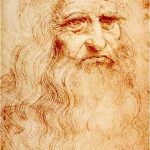 This specific study by Freud is not about Leonardo da Vinci’s art, but about the artist himself. Freud had a huge admiration for Leonardo and he identified himself with him. What both men seemed to have in common was that they both were their mother’s favorite and that their fathers were, literally with Leonardo and emotionally with Freud, absent. Both of them were men called ‘above category’ in cycling terms. Leonardo marks the transition from the Classic age to the Renaissance, the period in which the emphasis on collectivity was exchanged for focus on the individual, Freud finds himself on the threshold of Modern time which was increasingly more about the autonomy of the Self.
This specific study by Freud is not about Leonardo da Vinci’s art, but about the artist himself. Freud had a huge admiration for Leonardo and he identified himself with him. What both men seemed to have in common was that they both were their mother’s favorite and that their fathers were, literally with Leonardo and emotionally with Freud, absent. Both of them were men called ‘above category’ in cycling terms. Leonardo marks the transition from the Classic age to the Renaissance, the period in which the emphasis on collectivity was exchanged for focus on the individual, Freud finds himself on the threshold of Modern time which was increasingly more about the autonomy of the Self.
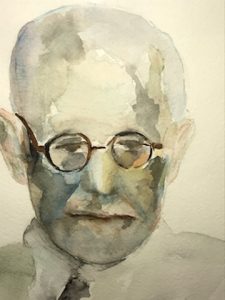
Freud by Liesbeth Dullaart
Introduction
It is often said that psychoanalysis is an art form and a science. Psychoanalysis is not only at the interface between psychology and biology, but is also at the border between art and science. Consequently, psychoanalysis, just like Leonardo the artist and scientist can not be defined and is elusive. Freud collected antique art from Egypt, Greece, the Roman Empire and also from China. The fact that his patients dreamt about Greek themes was because his room was filled with replicas of classic works of art. A couple of months after his arrival in London, after fleeing from Vienna, he wrote to Jeanne Lampl-de Groot that “all the Egyptians, Chinese and Greek had arrived in London without having been damaged too much”. In London, Freud writes: “they seemed more imposing than at the Berggasse”. The relationship between psychoanalysis and art has always been a very specific one. Freud used to use Leonardo da Vinci’s metaphors: ‘Per via di porre’ and ‘Per via di levare’ to clarify the difference between the supporting and the more exposing forms of psychotherapeutic intervention.
* As example for the use of the ‘via di porre’ da Vinci describes the art of painting. The painter covers the blank canvas with color and layers of paint just like suggestion and persuasion add something in order to achieve change and/or cure.
* This is contrasted by sculpture. This removes everything from the stone that is withheld from the view of the shape, trapped within the marble. This is what Da Vinci describes with the ‘via di levare’.
Just like sculpture, psychoanalysis does not want to add anything, it wants to extract something to liberate the individual and to bring forward its authenticity.
Freud made several journeys to Italy, the cradle of the Renaissance. After which he wrote two major works on art. One about painting and one about sculpture:
* In 1910 Leonardo da Vinci’s Childhood Memory.
* In 1914 Michelangelo’s Moses.
Both publications clarify much, both about the artist and about the writer. Like Moses guided the Jewish people from Egypt to the promised land and then offered them a monotheistic religion instead of a golden calf, Freud took his followers on the way to, what he called: a scientific psychology of the unconscious (1895).
The rest of this argumentation will be about Leonardo the artist and scientist, but especially about the pain and the loss out of which his creative legacy was born. In ‘Leonardo da Vinci’s Childhood Memory’, Freud demonstrates how important a child’s early pre-Oedipal relationships with the primary mother object are for its development, and what effect the absence of the early father object has. Love and Hate as well as the prohibition of them are key elements throughout Freud’s study about Leonardo da Vinci. Loss and creativity are in line with each other for Leonardo. However, before we continue our search for what in Freud’s views are the roots of Leonardo’s creativity, we will first discuss something about sexuality and seduction in Freud’s view.
Sexuality
Freud considered sexuality as the underlying factor for the development of pathology. On the other hand it is true that sexuality for Freud was not purely a biological concept. Sexuality/Libido is a mental representation and therefore arises within relationships. Sexuality are adjacent to both the somatic (physical) and the mental. Psyche and Soma are intensely connected. Sexuality is not something that autonomously and ‘naturally’ develops within a child. Sexuality comes from outside, from the grown-up world. Not primarily from the Father’s world but rather from the Mother’s world, which is demonstrated by the French psychoanalytic Laplanche. Behind the Oedipal triad in which father plays a dominant role, hides the dyadic, anaclytical relationship with mother. This is the core of Laplanche’s theory of seduction, it does not revolve as much around a coincidental seduction as around structural seduction by the primary mother object. The seducing mother is hidden behind the seducing father.
This vision on sexuality and the development of the sexual identity is extremely topical. These days his kind of vision is also formulated by Target (2007) and Fonagy (2008) in relatedness with the theory on mirror imaging by the primary parent objects. We will now return to Freud’s text on Leonardo.
Leonardo da Vinci
In Freud’s eyes Leonardo was “one of the greatest men of the Italian Renaissance, who was admired, and at the same time considered mysterious by all of his contemporaries, just as he still is by us (Freud). He was an all-round genius, whose contours one can only imagine, but never truly understand, who as a painter exerted the biggest possible influence on his period; first it was our (Freud) preserve to recognize the greatness of the scientist …. who merged inside him with the artist” (Freud 1910). In his book on Leonardo Freud introduces to us concepts like ‘sublimation’, ‘narcissism’, ‘mirroring’, ‘identification with’, and he discusses different expressions of sexuality. He founded the Oedipal conflict in the early mother-child relationship and connected it with ‘narcissism’. That way he describes the (homo) sexual identity as a merge between genetic dispositions on the one hand and specific identifications on the other. In the study in hand he seizes the sexual identity as rooted both from ‘Nature’ and ‘Nurture’. In his book about Leonardo Freud in fact returns to the first theory of seduction that he had abandoned earlier.
When talking about sublimation Freud describes the shift from the gratification of the sexual drive towards non-sexual or conflict bound activities which are, however, related to the former sexual purpose. “When we discover one extremely developed drive in one’s character, like Leonardo’s inquisitiveness, we invoke one specific aptitude to explain this, of which the probable organic determinants are often still unknown…. We consider it probable that this unusually strong drive has already been active in one’s earliest childhood and that the primate impressions from the child’s life were registered, and in addition we assume that this drive originally has used sexual forces for its reinforcement, in order to be able to take responsibility for its sexual life later on”(1910). Freud explicitly targets expressions of artistic and intellectual creativity, art and science. This quote deals with two different cases, on the one hand the phenomenon of the sublimation and on the other the positioning of the psychoanalysis as the interface between biology and psychology.
Concerning the latter Freud establishes the apparent behavior in the biological maturation here which does not mean however that the psychological development is an epiphenomenon of the biological maturation. It is not about a linear but about a circular causal relatedness. Freud establishes the sublimation in the compatibility of the drive to autonomy/ego-driven and to relatedness/sexuality. This way, sexual curiosity can lead to scientific curiosity about how things are wired. Later Freud would further develop sublimation towards a function from the Ego and thereby sublimation was connected to the concept of defense. He did gradually distance himself from the vision that sublimation would be a derivation of the drive. Many of the important questions psychoanalysis has dealt with and is still dealing with, can already be found in Freud’s study about Leonardo.
Freud describes Leonardo as a sophisticated, amiable and endearing man, fond of beauty, beautiful clothes, someone who appreciated all of life’s sophistication. But also as someone who avoided conflicts and enmities, peace loving and inhibited about aggression. Someone who struggled to finish his paintings and whose pace of work was extremely slow. Over the years Leonardo’s interest shifted from art to science. “His female sensitivity did not keep him from accompanying sentenced criminals on their way to their execution, to study their faces tensed up from fear and to draw them in his notebook, just like it would not prevent him from designing the cruelest weapons of attack and to become the highest military engineer of Cesare Borgia .……. His affections were curbed, subjected to a need for investigation; he did not feel any love or hate, but asked himself where something originated from, what he would need to love or hate and what this meant”. Sexuality, love and hate were turned into intellectual interest. He was not devoid of passion. “He had just turned passion into thirst for knowledge”, Freud wrote.
A Childhood memory from Leonardo da Vinci<
The respective memory mentioned in the title of the book is the following: “Because as a very early memory I remember that, when I was still in the cradle, a vulture came down to me, opened my mouth with its tail and whacked it many times against/between my lips”. This memory is considered a fantasy or a ‘screen memory’ by Freud. But a fantasy is never just a fantasy, usually it is founded in reality or connected with a ‘day’s residue’, in other words, a fantasy which is rooted in external reality. Fantasy and reality, the inside and the outside world are connected to each other in a complex way but do not coincide. The question Freud asks himself is what historical reality underlies Leonardo’s childish fantasy.
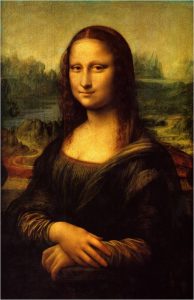 Freud’s answer to this is that the fantasy is connected to the fellatio but that ‘nursing’, the mother’s breast, hides behind the fellatio. Further into the text Freud connects the fantasy to being kissed intensely by the mother. He then connects this to Gioconda’s famous smile (the Mona Lisa). In Freud’s mind her smile expressed “the essence of femininity … abstinence and seduction … devoted tenderness and relentless coercing, sensuousness devouring men as something strange” (Freud 1910).
Freud’s answer to this is that the fantasy is connected to the fellatio but that ‘nursing’, the mother’s breast, hides behind the fellatio. Further into the text Freud connects the fantasy to being kissed intensely by the mother. He then connects this to Gioconda’s famous smile (the Mona Lisa). In Freud’s mind her smile expressed “the essence of femininity … abstinence and seduction … devoted tenderness and relentless coercing, sensuousness devouring men as something strange” (Freud 1910).
One could ask if Freud was not led by his own fantasies about his mother and his relationship with her, after all Freud was his mother’s favorite child and his father was not really there emotionally.
Regardless, according to Freud, Leonardo’s mother’s relationship to her son was permeated by unconscious sexuality. Whereas Leonardo’s mother tries to find in her son what she could not find in Leonardo’s father, because he had left her, in other words, Leonardo was raised by his mother in the absence of a father.
Leonardo’s childhood memory
Leonardo was born on April 15, 1452 in Florence and died May 2, 1519 in Amboise, France, where he was also buried. He was the illegitimate child of his father, a notary, and his mother Caterina, a poor farm girl. In the first year after Leonardo was born his father married the aristocratic Donna Albiera. However, their marriage remained childless. For the first years of his life Leonardo was raised by his mother in the countryside. The first years of his life are characterized by the absence of (hetero) sexual relationships. According to official documents Leonardo lived with his father and his wife in their house when he was 5 years old, and where he obtained an upbringing with more opportunities than he would have had with his biological mother. In his father’s household Leonardo did not only find his stepmother, but also his father’s mother, who will probably also have treated him with the usual love of a grandmother. The price Leonardo had to pay for this was that he had to undo his stepmother’s childlessness by taking the place of his father and stepmother’s unborn children. And that he once again had to experience a serious separation, this time from his biological mother. Exactly when he was taken into his father’s and stepmother’s household is not exactly clear.
* Leonardo and his Mother
For the first years of his life, Leonardo was raised by his mother, who was abandoned by her lover while he himself was abandoned by his father. Both his mother and Leonardo will have felt lonely and abandoned. Which had the consequence that the relationship between mother/Caterina and child/Leonardo will have been intense. Freud associates this with Leonardo’s childhood memory and especially the passage in which the bird whacked Leonardo’s lips with its tail. With the lack of a relationship with the father figure the breach of the dyadic relationship with mother or even the sacrifice of the symbiotic relationship with her will have been extremely complex for Leonardo.
Leonardo was not only his mother’s child but also had to take the place of her lover, by whom she had been turned down earlier and who had also rejected his son. Leonardo took the place of the absent lover in the relationship with his mother, while his mother had to compensate for the absence of his father as well as being his mother. Abandoning the dyad with her Leonardo was complicated and complex for his mother as well, still she gave up her son after a couple of years to the man who had abandoned her, and again Leonardo was abandoned, now by his mother who gave him away to her rival. Leonardo’s relationship with his mother was extremely ambivalent, both were victim as well as perpetrator. In this script separation and premature erotic overstimulation are the focus.
Freud linked the erotic overstimulation by mother to Leonardo’s (possible) homosexuality. Freud does however note that there are many forms of hetero/homosexuality in which identifications with other object as well as genetic dispositions play a role. According to Freud was the sexual identity in his study on Leonardo connected to a subtle interaction between genetic dispositions and environmental variables, or with the quality of the early parent – child relationships. In the beginning Freud kept pathology of the development and pathology related to inner conflicts together, later his focus would be more on the types of pathology related to inner conflicts.
Leonardo’s biological mother was seductive and incestuous because of the missing father. She was looking for security and intimacy with her son, which she would normally have hoped to have found with Leonardo’s father, in addition she was looking for consolation for the abandonment.
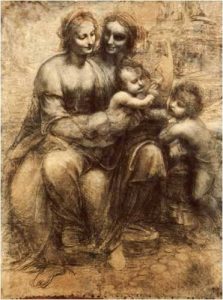
* Leonardo and his Stepmother
It is understandable that Leonardo’s relationship with his stepmother was also extremely complex. Firstly he had to make her childlessness bearable, while at the same time she was the cause of the loss of his biological mother. Furthermore she was responsible for Leonardo growing up without his father the first years. In addition Leonardo will have projected a lot of his aggression that was meant for his biological mother onto his stepmother in order to keep the image of his (seductive) biological mother as good and beautiful. But above all his life with her offered him opportunities which had been absent with his biological mother. In short, Leonardo’s inside world must have been colored by intense splitting affects of love and hate which were impossible to integrate because they were so intensely anchored in his external reality.
What cannot be incorporated has to be avoided and would thereby disappear from the communication between Leonardo and the others, (like his mother, stepmother and as we will find out after this also his father). Many of the events from Leonardo’s life could not be mentally represented in memories and would therefore stay out of the experience. We will get back to this at the end of the story, when we will discuss Freud’s quote of Leonardo at the end of his study.
* Leonardo and his Father
The relationship between Leonardo and his father was also complex and extremely ambivalent. He was his father’s first son who abandoned him initially to accept him into his house later on, after it had become clear that the stepmother would stay childless. Certainly a strong breeding ground for hate as well as love. Freud connected the absence of a restricting father during Leonardo’s first years in life to his later dismissive attitude towards authorities and the orthodoxy of religion. After all as an artist and scientist he found the freedom to create, to experiment and to research without feeling intimidated by fatherly authority. The early abandonment by his father and the following acceptance of Leonardo into his household will have evoked a lot of contradicting feelings in the young Leonardo which would have severely restricted the engagement into the Oedipal rivalry with his father. In addition the early abandonment of his father will have triggered feelings of shame and a feeling of “not being good enough” with Leonardo. Because of his father’s behavior he was a bastard and therefore a second-class citizen. Not good for a solid and consistent self-esteem.
The complexity of his early childhood will have invoked questions with the young Leonardo: about his own origin, about how it works getting children, where do they come from, how does pregnancy work, and what is the role and place of fathers and mothers in this? Where do I come from and why did my father abandon me?
In Freud’s perception Leonardo has managed to make his need for care and love for the primary objects, (the present, dominant, sexually overstimulating mother and his absent father), manageable by converting his needs into artistic creativity, scientific inquisitiveness and his assumed homosexuality.
In the period in which Freud started to put the Oedipal conflict more and more in the center of his thoughts, he emphasized the meaning of the pre-Oedipal relationship between the child and the primary objects in his book about Leonardo, thereby he returned essentially to his former theory of seduction. Behind the triad of the Oedipal conflict hides the dyad with the mother object. Seduction and abandonment go hand in hand in Leonardo’s life. The early abandonment by his father complicates the separation of mother and child.
The dyadic seduction by the primary mother object results in a narcissistic development of the child. In the narcissism the child perceives itself as the first ‘other’ object after the symbiotic relationship with the mother. Such an experience can be enhanced by the adoration of the mother object. The dyadic phase with its emphasis on the significance of the parent – child relationship, the narcissistic development and the triadic Oedipal conflict come together in Freud’s work about Leonardo da Vinci in a coherent meaningful network, not a triad without a dyad and vice versa. In this context it is continuously about attachment and detachment, about separation/abandonment and relatedness, about autonomy and relatedness. The line between creativity and destructivity is alarmingly thin in this case.
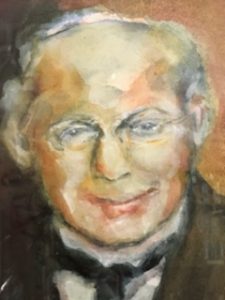
Sándor Ferenczi by Liesbeth Dullaart
In Freud’s studies about hysteria (1895) it is the father who introduces sexuality into a child’s life, with the return of the first theory of seduction, however, Freud moves the accent from the father to the mother. It is Ferenczi who widens the perspective from the father to the mother and consequently to the grown-up in his beautiful article written in 1933, ‘The Confusion of Tongues’. Father and mother are not only their child’s father and mother but also each other’s lovers. Fathers and mothers stroke, wash, hug, console and kiss their child. Fathers and mothers seek the gratification of their sexual needs and desires in each other as lovers and therefore they hug, stroke, kiss and make love to each other. The language between fathers and mothers differs from that of lovers but at the same time they are similar.
It has to be clear that not all kisses or hugs are the same. If that would be the case then things get mixed up and there would be question of ‘confusion of tongues’. At such time the thinking/fantasizing about sexuality stops, thoughts, feelings about sexuality are no longer generated and exchanged, the ‘as if mode gets blocked. This is the case with overstimulation by the parents, with sexual traumatizing and abuse. Sexuality is then removed from the communication between the parent and the child because it is too threatening, the fantasy becomes reality; that is what happens with sexual abuse and with sexual boundary violation in a treatment. Wishes and desires from a small child are different from those of adults. Parents can not completely satisfy the wishes and desires of their child nor can they represent them moreover because sexuality stems from the period before there even was something like a mentalizing ability. This implies that sexuality remains relatively unmentalized because the parents cannot represent this adequately, emotionally and cognitively for their children. The sexual desire is limitless.
To rephrase the above it means that the small child is continuously confronted in a structural way with sexual significances it does not create itself, which do not come from within, but from the outside and for which the child is not ready because it is not (yet) able to integrate these significances cognitively and emotionally. This brings us to the concept of ‘Nachträglichkeit’.
Nachträglichkeit
Freud describes a number of events from Emma’s life in his ‘Project for a scientific psychology’ (1895) with which he tries to explain how only afterwards, secondarily an event can be experienced as traumatic. Emma is touched in a lewd manner by a grocer as an 8 year old girl. At that moment there is no traumatic effect because Emma is not yet able to place the event cognitively and emotionally in its sexual meaning. Traditionally said, Emma represses the event and this works. These days we would say that the for Emma incomprehensible event would remain misunderstood, and does not get a place in Emma’s communication with her environment. Only after a couple of years when Emma reaches puberty and enters a clothes store where she is being laughed at by the sales people the first event gets a pathological meaning after all. She immediately understands the men are laughing at her clothes and she develops a phobia. To Freud the second (in itself innocent) situation becomes connected to the first (seductive) scene via a complex network of associations, which brings this first scene back to the edge of consciousness, or there is question of “the return of the repressed event”. Because Emma has not been able to develop any thoughts and feelings around sexuality during the first scene, she now does not manage to deal with it and feels handicapped. She will now perceive the first situation as sexually seducing due to the fact she has reached puberty with all its hormonal colored consequences. But because she has not been able to generate any thoughts and/or feelings about it now she cannot do anything with it. To her sexuality is an unexplored area and blank spot.
Sexuality comes from the outside (the seduction by the other person) and only gets its actual sexual and traumatic meaning afterwards. We will revisit this at the end of our story at which time we will talk more explicitly about the unconscious.
The ‘Smile’ in Leonardo’s work
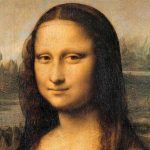 Winnicott strongly emphasizes the meaning of the early parent relationship in his work. He makes it clear that the first thing the child sees is: itself mirrored in the eyes of the mother. These days we know that it is not the child itself that is mirrored but the relationship between mother and child. The expression on the mother’s face expresses something about the affective relationship of the mother towards her child. The mother’s gaze is full of meaning, it can be loving or hating, happy or full of sadness, protective or threatening, offering safety or unsafety. The child will therefore seek its mother’s gaze for its self-expression and need for security just like the mother will seek the gaze of its child. The child sees itself through the eyes of the other person, the mother. The child will try to read the mother in order to get to know and understand itself. Within the dyad mother and child facilitate and stimulate each other. They form a unity, inter-subjectivity from the start. In the gaze of the mother and child it’s about the nature of being seen, about sensitivity and responsivity. It is both the primary mother object as well as the father object that will support the child with its process of separation because of their adequate sensitivity and responsivity. What is important here is that the relationship between the father and mother is good or in other words safe.
Winnicott strongly emphasizes the meaning of the early parent relationship in his work. He makes it clear that the first thing the child sees is: itself mirrored in the eyes of the mother. These days we know that it is not the child itself that is mirrored but the relationship between mother and child. The expression on the mother’s face expresses something about the affective relationship of the mother towards her child. The mother’s gaze is full of meaning, it can be loving or hating, happy or full of sadness, protective or threatening, offering safety or unsafety. The child will therefore seek its mother’s gaze for its self-expression and need for security just like the mother will seek the gaze of its child. The child sees itself through the eyes of the other person, the mother. The child will try to read the mother in order to get to know and understand itself. Within the dyad mother and child facilitate and stimulate each other. They form a unity, inter-subjectivity from the start. In the gaze of the mother and child it’s about the nature of being seen, about sensitivity and responsivity. It is both the primary mother object as well as the father object that will support the child with its process of separation because of their adequate sensitivity and responsivity. What is important here is that the relationship between the father and mother is good or in other words safe.
Can I be my own or do I have to be an extension of the mother, the other. The child needs the assistance of a caring father to break through the dyad with its mother and to enter the world of the triad. That is the world of sharing, the world in which the other truly is another with its own life, own wishes and desires.
In his study about Leonardo Freud is, just like many others, fascinated by the smile of the virgin Mary and her mother in the painting ‘Madonna with child and the holy Anna’ as well as by the smile of the ‘Mona Lisa’. He describes the smile on the lips of the women as mysterious: “it is a fixed smile, on elongated curved lips”. It is this specific smile which is characteristic for Leonardo that fascinates the spectator and leaves him in a state of confusion. In Freud’s approach Gioconda’s smile made Leonardo think unconsciously about his mother’s smile and therefore about the relationship with his mother. Because of Gioconda’s smile the repressed memory of his adoring mother was being activated again, it is about the return of the repressed.
Freud considers the characters in the painting ‘Madonna with child and the Holy Anna’ as the representations of Leonardo’s biological mother Caterina coinciding with his father’s mother Monna Lucia, and as a representation of Leonardo’s stepmother Donna Albiera. It is about a transgenerational perspective. Freud considers the child Jesus to be the representation of Leonardo himself, the narcissistically colored delusion of grandeur stands out immediately in this last representation: Leonardo as Christ. On the other hand the mother figures are also being idealized in the personae of the Madonna, the mother of God and the holy Anna. It’s about the adored son of an idealized mother, a strong breeding ground for a narcissistic development. It’s about a child being born of a virgin, therefore independent of sexuality, a true son of God.
The smile in Leonardo’s paintings is usually interpreted, and also by Freud, as ambivalent: hesitant and seducing at the same time, good and bad, it is as much about the smile of the Madonna as about the smile of the whore, young and old coincide, seducing and castrating. It continuously deals with the themes seduction and separation.
Mona Lisa
Mona Lisa’s smile refers to Leonardo’s previously discussed child fantasy, in which Leonardo’s yearning memories of his mother’s loving kisses come together. Caterina blended the tenderness of a mother for her child with the passion of a lover for her lover. That way she made the abandonment of her lover as well as the fatherlessness of her child bearable, for herself as well as for Leonardo. This ambiguous tenderness was fatal for Leonardo in his later life, it determined his fate and the way his life took shape. With this her child became the surrogate of her husband to her and she refrained Leonardo from a part of his masculinity by the very early maturation of his eroticism. Caterina was in Freud’s opinion not adequately equipped to differentiate between and properly read into her child’s language and that of her own as an adult. 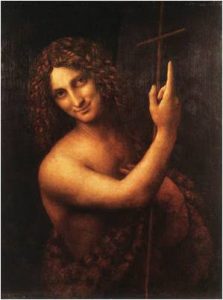
Leonardo painted his Mona Lisa at a time when he had long, as Freud describes: “transformed his sexual feelings and passions into scientific inquisitiveness and artistic creativity. The mysterious smile of his model, the Mona Lisa evoked in Leonardo the memory of the loving and seducing smile of his biological mother, it was about the return of the repressed. It was that smile he tried to paint, not only in the Mona Lisa but also in other female characters in his other paintings. It became his trademark and would be named ‘Leonardesque’. We do not only see the Leonardesque smile with Leonardo’s female characters but it can also be detected on John the Baptist’s face. A lot of the characters Leonardo painted have something androgynous to them. Possibly Leonardo, who is known not to have had any lasting relationships in his life, denied the misfortune of his love life in the mysteriously smiling forms, and artistically overcame this by shaping the wish fulfillment of the small boy who has been enchanted by his mother in the happy unification of the male and the female”.
Thereby attempting to capture his unconscious sexual desire for his mother in his paintings. The smile was there before the painting, and it came from the outside.
Madonna with child and the Holy Anna
We see the mysterious ‘Leonardesque’ smile return in the female characters of the painting ‘Madonna with child and the Holy Anna’. 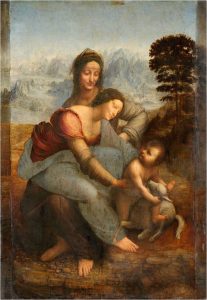 The synthesis of Leonardo’s youth lies, according to Freud, in this painting, painted after the Mona Lisa: the absence of his father, raised by several mothers, his biological mother, his stepmother and his father’s mother, all of this is connected to the early fantasy of the child mentioned by Leonardo himself in this painting. Oskar Pfister made a remarkable and interesting discovery with respect to this painting, which was not and still is not accepted by everyone. He discovered the contours of the bird from Leonardo’s previously described memory, in Maria’s peculiarly designed and mysterious clothing, thus completing the cycle.
The synthesis of Leonardo’s youth lies, according to Freud, in this painting, painted after the Mona Lisa: the absence of his father, raised by several mothers, his biological mother, his stepmother and his father’s mother, all of this is connected to the early fantasy of the child mentioned by Leonardo himself in this painting. Oskar Pfister made a remarkable and interesting discovery with respect to this painting, which was not and still is not accepted by everyone. He discovered the contours of the bird from Leonardo’s previously described memory, in Maria’s peculiarly designed and mysterious clothing, thus completing the cycle. 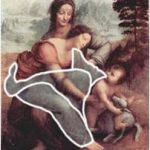
The holy Anna was Maria’s mother, who in turn was Jesus’ mother. A striking detail in the painting is that one would expect the holy Anna to have been painted a generation earlier than the holy Virgin Mary, which is not the case. Leonardo has given Jesus two mothers in the painting. Leonardo has also painted both characters in a way that makes it hard to work out where Maria’s contours start and where St. Anna’s finish, they flow into each other. Leonardo has both mothers blur into each other. The biological mother and the stepmother blur into one another in the composition of the painting. “With the blissful smile of the holy Anna (character in the background) the artist has perhaps denied and covered up the envy the unhappy woman (Caterina, the mother) felt when she had to give up her son to the distinguished rival, just as she had had to give up her husband earlier”. A similar way of blurring can be found in a famous ‘cardboard’ which had served as a first stage for a later painting on which the holy Virgin Mary with her child, as well as the holy Anna and John the Baptist as a small boy, are depicted. This ‘cardboard’ was never turned into a painting and was drawn before the Mona Lisa was painted.
The cardboard with the drawing of Maria with child and the holy Anna and John the Baptist but also with Madonna with child and the holy Anna can also be viewed in a different way, namely as a precursor of what D. Stern would later describe as the motherhood constellation. Mother Maria is not just Jesus’ mother, but also her own mother’s child, the holy Anna. In short it is not only about the merging of Maria/Caterina with Jesus/Leonardo but also about the merging between Maria and her mother the holy Anna.
Just to be clear, Gioconda’s smile does not just refer to Caterina’s adoring attitude towards Leonardo but also to the hidden fury and painful grief caused by Leonardo’s father’s rejection as well as the fact that her child was taken away from her. Moreover it is not only the holy Virgin and the holy Anna that blur and flow into each other, also the child, the Christ is hard to outline from the mother objects. This is why this painting was also named ‘Earthly Trinity’ in contrast to the ‘Divine Trinity’. Merger and separation, autonomy and relatedness, hate and love, with Leonardo they all go hand in hand beyond the generations.
The last Supper
When we talk about Leonardo’s identification with Jesus it is interesting to include another famous painting from Leonardo, namely the Last Supper. Leonardo paints this supper on a very specific moment which is the moment that Jesus informs his disciples that one of them is going to betray him and hand him over to his enemies. Great consternation and panic follows. Leonardo portrays the reactions of the different disciples mainly via the language of their arms and hands. Peter: passionate and reacting. Judas: stoic and frozen, he is the only one that does not panic, he knows what is going to happen. Jesus: soothing and open, receptive.
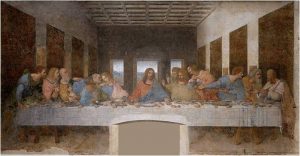 Jesus is placed in the center of the painting, both the light and the perspective are aimed at him. The painting is about betrayal and abandonment, a theme very familiar to Leonardo looking at his history. It was Jesus on the cross who called: “Father, my father, why did you abandon me?” This biblical sentence could be characteristic for Leonardo’s life and his quest for its meaning. Jesus, Leonardo and Freud: they are connected to each other somehow, all three of them adored by their mothers, all three of them with an absent father, all three of them something with greatness and questions regarding sexuality.
Jesus is placed in the center of the painting, both the light and the perspective are aimed at him. The painting is about betrayal and abandonment, a theme very familiar to Leonardo looking at his history. It was Jesus on the cross who called: “Father, my father, why did you abandon me?” This biblical sentence could be characteristic for Leonardo’s life and his quest for its meaning. Jesus, Leonardo and Freud: they are connected to each other somehow, all three of them adored by their mothers, all three of them with an absent father, all three of them something with greatness and questions regarding sexuality.
Summarizing until now
Leonardo grew up without a father during the first 5 years of his life and with a mother who exceeded the moral boundaries with all the consequences for his psychological development. Within a normal development, the presence of the father object next to the mother object is very important and will enable the child to differentiate between the Self and the Object. It is the fatherlessness and the dominance of the primary mother object, that have determined Leonardo’s life. Neither father nor mother were present in his life as adequate sensitive and responsive objects for a healthy development. He was able to sublimate the absence in his life and this has turned him into the genius that he has become: great as an artist as well as a scientist. Nevertheless he was balanced on the edge of creativity and destructiveness. Creativity as an attempt to keep trauma, loss and pain manageable.
His early childhood is colored with a lot of separations, intense ambivalences, lots of love, but also much hate. This will have strongly affected his self-esteem. His mother’s adoration will have also played a major role in this. The way individuals deal with conflict, shortages and trauma in their life differs widely.
Fatherlessness causes the boundaries between mother and child to become less clear than in a situation where a caring third object is present from the start. On one hand fatherlessness can cause rejection of the rules and boundaries and therefore a destructive denial of the external reality. On the other hand it can also result in an awareness of being left to oneself, because of the lack of an external authority, which absence in a way is being repaired and compensated by the construction of the inner authority. Creativity and success but also self-destructiveness lie in wait. In Leonardo’s case the fatherlessness and the connected dominant presence of the primary mother object facilitate sublimation of the sexual drive towards voyeurism and art, on the other hand towards scientific inquisitiveness. What matters is whether somebody has the potential to allow himself to turn the pain from the absence into inner growth and freedom of thinking. The risk is that the rejected child will keep considering himself as bad and will therefore need to punish himself by not allowing himself any success. Or from another perspective: does life need to be dominated by a continuous need to prove that you are worth to be looked at as a child? Central to this is the experience of not being seen by neither father nor mother. But later on neither was he seen by his stepmother. To her he took the place of her unborn children. Failing sensitivity and associated failing responsivity from parental object befell him.
The area of creation
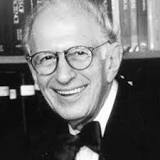 Balint (1968) discussed in his book about the basic fault three different levels of mental functioning, which can be helpful in understanding the creative development of Leonardo.
Balint (1968) discussed in his book about the basic fault three different levels of mental functioning, which can be helpful in understanding the creative development of Leonardo.
• The first one is about the Oedipal way of functioning, where there are two other objects next to the child. There, the quality of the relationships is triadic. In this area the patient can be open to an interpretation. It is the area of mentalized representations.
• The second one is the area of the basic fault, in that case there is next to the child only one other object, there the relations are dyadic. The patient is unable to be open to interpretations. It is the area of unmentalized representations. In that case, the child will either invest in himself (philobatic) and not in the other, or in the other (ocnophilic) and not in himself. It is focusing either on the autonomy or on the relatedness.
• The third one is the area of creation. In that case, there is no other gratifying object available for the child than the child itself. It is the area of being detached. The child is trying to create from his inside a more satisfying relationship with the external world than external object can give. He is doing this by creating art or scientific efforts but also by creating illnesses or pathology. No object, no object-relation and by that, no transference. There are no relationships with people, only with functions in this area. Traditional psychoanalytic technique is of no use. In the area of creation, there are no objects, but we know also that for some time Leonardo was not completely alone. Balint states that we don’t have adequate words to describe that ‘somethings’ that were there when the subject was not completely alone. He proposes the term ‘pre-object’, and he is comparing it with Bion’s alpha and beta elements, and alpha function. Those pre-objects are so primitive that they are not ‘organized’ or not ‘a coherent whole’. Only after the work of creation has succeeded in making them ‘organized’ can a verbal or Oedipal interaction between them and external objects take place. Balint is explicitly mentioning Leonardo da Vinci talking about the area of creation.
As always, it is about the joining of Love and Hate, of Creativity and Destructivity. That is what matters in the art world and in the world of the psychoanalysis.
“Vol ist zahlloser Ursachen die niemals in die Erfahrung traten.”
I would like to conclude this story with Freud quoting Leonardo da Vinci at the end of his study about Leonardo. Freud uses this quote at the end of his book about Da Vinci (1910). The quote is about nature in general, but Freud applies it to human nature or what we would call today the ‘mind’ or ‘inner world’. He points out that lots of things are stored in our mind that cannot and will not be reflected in memories. In short, we discover the beginning of Freud’s vision on the unconscious summarized in this quote.
* One of the causes of the unconscious lies in the fact that certain events fall outside the communication between the individual and its surroundings because certain aspects of the interaction have not or not adequately been represented in cognitive or affective perspective by the other person.
* Another cause can be that the truth resembles the developing child’s fantasy too much, at these moments fantasizing gets blocked (compared to what we said earlier regarding the Nachträglichkeit concept). It is necessary to repress because the mentioned event still cannot be represented as an affective and cognitive schema and therefore cannot be included in the experience. Incomprehensible events remain in an incomprehensive status as if they were sleeping dogs (the repression is successful) until, nachträglich, the sleeping dogs are woken up by a specific event that is associated to the initial event (the return of the repressed).
This dynamic unconsciousness needs to be differentiated from what Fonagy calls the ‘Nonconsciousness’, and what Sandler calls the ‘descriptive or procedural unconsciousness’. The latter deals with experiences that are procedurally stored in our brain outside the verbal mediation. This procedural unconsciousness needs context dependent passwords to be able to be retrieved.
From the start, sexuality principally belongs to the domain of the unmentalized procedural unconsciousness, which does not mean, however, that there are no sexual problems to which Freud’s psychodynamics are not applicable, but … desire is never extinguished.
Dr. M. de Wolf
